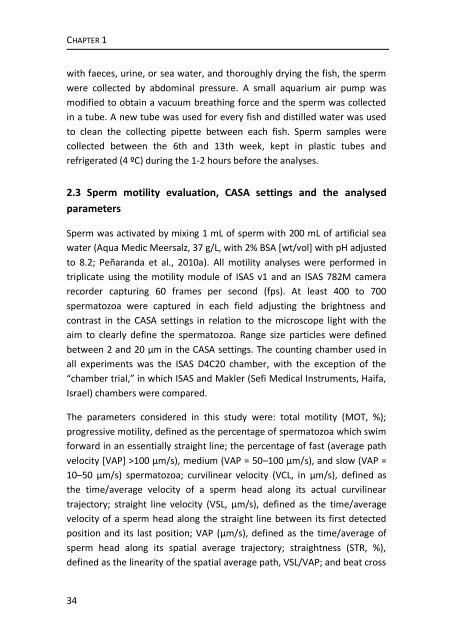chapter 3 - RiuNet
chapter 3 - RiuNet
chapter 3 - RiuNet
You also want an ePaper? Increase the reach of your titles
YUMPU automatically turns print PDFs into web optimized ePapers that Google loves.
CHAPTER 1<br />
with faeces, urine, or sea water, and thoroughly drying the fish, the sperm<br />
were collected by abdominal pressure. A small aquarium air pump was<br />
modified to obtain a vacuum breathing force and the sperm was collected<br />
in a tube. A new tube was used for every fish and distilled water was used<br />
to clean the collecting pipette between each fish. Sperm samples were<br />
collected between the 6th and 13th week, kept in plastic tubes and<br />
refrigerated (4 ºC) during the 1-2 hours before the analyses.<br />
2.3 Sperm motility evaluation, CASA settings and the analysed<br />
parameters<br />
Sperm was activated by mixing 1 mL of sperm with 200 mL of artificial sea<br />
water (Aqua Medic Meersalz, 37 g/L, with 2% BSA [wt/vol] with pH adjusted<br />
to 8.2; Peñaranda et al., 2010a). All motility analyses were performed in<br />
triplicate using the motility module of ISAS v1 and an ISAS 782M camera<br />
recorder capturing 60 frames per second (fps). At least 400 to 700<br />
spermatozoa were captured in each field adjusting the brightness and<br />
contrast in the CASA settings in relation to the microscope light with the<br />
aim to clearly define the spermatozoa. Range size particles were defined<br />
between 2 and 20 µm in the CASA settings. The counting chamber used in<br />
all experiments was the ISAS D4C20 chamber, with the exception of the<br />
“chamber trial,” in which ISAS and Makler (Sefi Medical Instruments, Haifa,<br />
Israel) chambers were compared.<br />
The parameters considered in this study were: total motility (MOT, %);<br />
progressive motility, defined as the percentage of spermatozoa which swim<br />
forward in an essentially straight line; the percentage of fast (average path<br />
velocity [VAP] >100 µm/s), medium (VAP = 50–100 µm/s), and slow (VAP =<br />
10–50 µm/s) spermatozoa; curvilinear velocity (VCL, in µm/s), defined as<br />
the time/average velocity of a sperm head along its actual curvilinear<br />
trajectory; straight line velocity (VSL, µm/s), defined as the time/average<br />
velocity of a sperm head along the straight line between its first detected<br />
position and its last position; VAP (µm/s), defined as the time/average of<br />
sperm head along its spatial average trajectory; straightness (STR, %),<br />
defined as the linearity of the spatial average path, VSL/VAP; and beat cross<br />
34
















